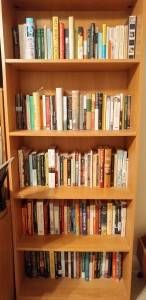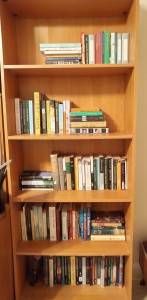Want to do the same? Perhaps these steps will work for you. (If you want to weed all your shelves, check out fellow rioter Jess’s post.) Step 1. Reflect. Why do you want to cull your shelves? For me, it’s partly about space. I live in a one-bedroom condo, and my shelves are overflowing. My unread books won’t fit on a single bookcase, so I’d been keeping the books I plan to read this year on a windowsill. I don’t have room for many more bookcases. Plus, because I do want to read the books I own, their presence can sometimes stress me out. They’re an impossible do-list, not a collection of possibilities to indulge in when I feel like it. Step 2. Take stock. Look at how many books you own. When I started culling, my LibraryThing inventory showed that I owned 206 unread books. I decided not to worry about unread ebooks. They don’t bother me. Once I eliminated those from consideration, I had 174 books to think about. Step 3. Get real. Consider how many of these unread books you’re likely to read in what you consider a reasonable amount of time. In a typical year, I read 75 to 100 books. With just over 200 books in my TBR pile, it’ll take me more than two years to read all my books if I only read my own books. Because I like to give myself freedom to read new books, book club books, and books that catch my fancy, that’s not realistic. Given my usual habits, it’ll take closer to five years to read them all, and I know I’ll keep acquiring more. Step 4. Choose a destination. How will you get rid of your books? You can swap books at sites like Paperback Swap, but you’ll just end up with other books. You can sell or trade for credit at used bookstores, but you’ll likely just end up with more books. I like to keep things simple, so I usually donate to the local library. Step 5. Figure out what you’ll never read. This step was not useful for me. I was still interested most of my books. Once I looked through my shelves, I found only five that I didn’t care to read. Most of these came to me when I was participating in my local indie’s signed first editions book club. Step 6. Adjust your mindset. Here’s where it gets hard. Part of me has always believed that having books on hand makes it more likely I’ll read them sooner, but that hasn’t proven to be the case. Better to get them from the library when the mood hits. I also get grumpy at the idea of all that wasted money if I get rid of books I bought, some of them brand-new. But I’ve already spent that money. Keeping the books won’t get me that money back, but having them around incurs a stress-and-annoyance cost. And it’s nice to think about someone coming across a signed first edition at a library book sale. Similarly, to show tangible support authors of color, I’ve bought a bunch of their books that I want to read. I want to further support them by reading and reviewing these books. Getting them from the library when the time comes encourages the library to continue buying their books. And donating them to the library sale promotes them to readers in my community. Step 7. Check your library. I hate the idea of getting rid of books, then being unable to find them when I want to read them. So I looked up all my print books at my local library’s online catalog and added tags on LibraryThing indicating whether they were at the library or not. This step revealed 88 books I couldn’t get at the library but that I still wanted to read. Those are all keepers. This left 87 books in play. Step 8. Set parameters. I decided that instead of coming up with reasons to get rid of books, I needed to come up with reasons to keep them. These are the reasons I decided on.
Gifts from friends and family stay. Once I’ve read (or attempted to read) gift books, I don’t feel obliged to keep them, but I don’t like the idea of not even giving them a try. Books I’ve gotten very recently stay. I’d like to get to a point where I read (or attempt to read) books within a month or two of purchasing them. I haven’t been able to manage it yet, but I’ve done pretty well so far this year. Really special editions stay. I have a few nice copies of older books that I don’t want to part with. When I subscribed to the Book Riot Quarterly Box, a couple of the books included annotations that I wouldn’t want to lose. And I’m a sucker for little paperbacks with French flaps. Weirdly, this rule did not include signed books. Unless it’s a book I love, I don’t care about signed books, especially if they’re big unwieldy hardcovers. Books I’m going to want to take notes in stay. I find it easier to concentrate on complicated books if I can interact with them by making notes in the margin. So I kept a few books that I know I’ll want to make notes in. Books that I won’t read quickly stay. I do not want to get partway through a library book and then have to return it. If it seems likely that it’ll take me a few weeks to work through a book, I’d rather hold onto it than take that risk.
Step 9. Enjoy the Results! Once I followed these steps, I had three bags of 57 books to donate. And I only had 122 books to fit on my bookcase. All my unread books now fit on a single bookcase with room to spare! Now I’d better take all those books to the library before they creep back onto my shelves.

